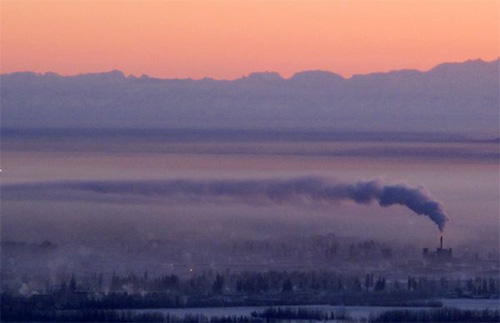ALASKA SCIENCE The rigors of research in the coldBy NED ROZELL
January 08, 2017
Boertje brought three thermometers with him on his graduate study. He confirmed 60 below while he and another student watched caribou in a valley below.
Fairbanks endures 40 degrees below zero, when the safest place for field scientists is in front of a computer.
Boertje says he would never work at those temperatures today, and not just because he’s no longer a graduate student. “Airplanes don’t work that well and helicopter pilots won’t fly at all,” he said of 40 below temperatures and the ice fog that comes with them. And the caribou? Boertje said the animals didn’t seem to mind the cold temperatures. “They had a very similar pattern to summer time. They’d lay down, then get up to graze for about an hour just like they would if it was warm.” Biologist Craig Gardner followed wolverines around the Alaska Range for his master’s degree. The temperatures in the Susitna River basin that December ranged from 40 to 55 below. He remembers firing up the MSR stove to stay warm during the 15 hours he spent in the tent each day because of darkness. “It was kind of fun, but I was younger then,” Gardner said. He and a partner tracked wolverines during the light of the day, finding that the animals moved a lot without covering much distance, sometimes hunkering in snow caves. Gardner didn’t lose any fingers during the study, but said he wouldn’t want to repeat the experience. “I wasn’t too sad when we got plucked out of there.” As someone who studies snow, Matthew Sturm has spent up to 40 days in the field during the winter. Much of his research is on Alaska’s North Slope, known to be a windy, dark, cold place. Sturm, who works for the UAF’s Geophysical Institute, has traversed the North Slope on snowmachine and tracked vehicle, taking thousands of snow-depth and other measurements. His trips have taken him from the Brooks Range to the Arctic Ocean to Hudson Bay as he gathers data that help scientists quantify the blanket of snow that both insulates the Arctic and reflects sunlight. Though he usually traverses the landscape in March, temperatures can still drop to 40 below. Sturm and his colleagues usually stay in an Arctic Oven tent, but the tent doesn’t help when it’s time to take measurements. “We have a lot of sophisticated equipment that gets trashed in the cold,” he said. “And something that would take two minutes to fix on a normal day takes hours to fix in the cold.” When the frigid air descends, most scientists opt to stay inside and make sense of data gathered in their studies, a task well suited for Alaska winters. “We’re hunkered in front of a computer,” he said.
Since the late 1970s, the University of Alaska Fairbanks’ Geophysical Institute has provided this column free in cooperation with the UAF research community.
Representations of fact and opinions in comments posted are solely those of the individual posters and do not represent the opinions of Sitnews.
|
||

